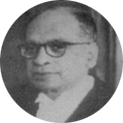K.S. Rao

K.S. Rao
9th Chief Justice of India
Assumed Office30th Jun, 1966
Retired On11th Apr, 1967
Previously
Chair of committee leading legal education reforms at Bangalore University1975-76
Contests Presidential electionsApril 12th, 1967
Resigns as Chief Justice of IndiaApril 11th, 1967
Appointed Chief Justice of IndiaJune 30th, 1966
Appointed Judge at the Supreme CourtJanuary 31st, 1958
First Chief Justice of Andhra Pradesh High Court, HyderabadNovember 1, 1956 - January 1958
Chancellor, Sri Venkateswara University1954-55
First Chief Justice of Andhra High Court, GunturJuly 5, 1954 - October 31, 1956
Judge, Madras High CourtMarch 22, 1948 - July 1954
Briefly joins the subordinate judiciary as munsif, resigns after 6 months and returns to Madras bar1933
Enrols as an advocate at the Madras High CourtDecember 13, 1926
Profile
Born on July 15 1902 in Rajahmundry (Andhra Pradesh), Justice Koka Subba Rao served as the 9th Chief Justice of India. While at the SC, Rao J authored 42 solo dissents—with some even referring to him as the ‘greatest dissenter in Indian judicial history’. Interestingly, a majority of these dissents were in favour of private parties contesting Government actions—and none of them were issued after he assumed the CJI’s office.
Rao J was raised in a family of lawyers and Judges. His father, K. Subhrahmaneswara Rao Naidu, and his grandfather, M. Venkata Ratnam Naidu, were prominent members of the Rajahmundry bar. After marriage, his father-in-law P. Venkataramana Rao served as the Chief Justice of the Madras High Court (1935-42) and then the Mysore High Court (1943-48). P.V. Rajamannar, his brother-in-law, went on to become the first Indian Chief Justice of the Madras High Court (1948-61).
In 1933, after completing his B.A. (1923) and B.L. (1925), Rao J enrolled as an Advocate at the Madras High Court. During his time at the Court, he served as Secretary of the Advocates’ Association In 1948, he was appointed as a Judge at the Madras High Court—the same year his brother-in-law assumed the office of Chief Justice.
Rao J was appointed as the first Chief Justice of the newly formed state of Andhra in 1954. When the Telangana and Andhra were combined, giving rise to a new state of Andhra Pradesh in 1956, Rao J became the first Chief Justice of the Andhra Pradesh High Court. On January 31 1958, he was appointed as a Judge at the Supreme Court. On June 30 1966, Rao J was appointed as the ninth Chief Justice of India.
Nine months into his term, Rao J accepted the then Leader of the Opposition’s offer to run for the Presidential Elections—leading to his demitting from the CJI’s office on April 11 1967. Rao would go on to lose the election to Dr. Zakir Hussain—however, his actions did win him the title of the first SC Judge to resign for a career in politics, as well as much public scorn too.
Post-retirement, Rao largely focused on publishing on and discussing Constitutional rights. He was a vocal critic of the 1975 Emergency. Rao J passed away on May 6 1976, in the throes of the Emergency.
During his nine years at the SC, Rao J wrote 351 Judgments and sat on 338 Benches. In 1963, he authored 63 Judgments.
While at the SC, Rao J was known as a staunch defender of Fundamental Rights. He largely presided over matters related to direct taxation, however, he was also recognised for his support of private property—as seen in his Judgment in Golaknath v State of Punjab (1967).
Notable Judgments
Basheshar Nath v CIT, 1958
In Basheshar Nath v CIT, 1958, the Court held that Fundamental Rights could not be waived. In his concurring Judgment, Rao J said that while it was true that in the United States fundamental rights could be waived, the same conditions did not hold good in India. In the United States, rights were evolved by the judiciary. Fundamental Rights in India were introduced in the public interest by the Constituent Assembly. Indian Courts cannot impose further limitations (such as waivers) on Fundamental Rights apart from the restrictions that are already otherwise contained in the Fundamental Rights Chapter.
According to Rao J, the majority of people in India are poor, educationally backward, and unaware of their rights. They cannot be pitted against the State and put in a situation where they may be compelled to waive their Fundamental Rights.
Kharak Singh v State of Uttar Pradesh, 1962
In Kharak Singh v State of Uttar Pradesh, 1962, the Supreme Court struck down State Police Regulations that allowed the police to make unannounced visits to the homes of ‘habitual criminals’ or persons likely to become habitual criminals. The Court invalidated this regulation on the ground that it was an executive order and not a law—the Right to Life could be restricted only by law. However, it rejected the claim that there was a fundamental right to privacy. In one of Rao J’s most famed dissents, he argued that the Right to Privacy was an essential element of personal liberty and was, therefore, a fundamental right. This view was upheld in K.S. Puttaswamy v UOI, 2018, where a nine-Judge Bench of the SC recognised the Right to Privacy as a Fundamental Right.
Golaknath v State of Punjab, 1967
In Golaknath v State of Punjab, 1967, Chief Justice Rao, writing for the majority, held that Parliament did not have the power to amend Part III of the Constitution which details the Fundamental Rights. Through this Judgment, Rao J introduced the ‘doctrine of prospective overruling’ to the Court’s jurisprudence. As per this doctrine, the Court’s ruling would have a prospective effect. While future Amendments to Part III would be barred, the Judgment would not impact previous Amendments. The previous Amendments would hold good.
Golaknath was subsequently overruled in Kesavananda Bharati v State of Kerala, 1970, where the Court held that Parliament had the power to amend all parts of the Constitution, including Part III. Only the ‘Basic Structure’ of the Constitution was insulated from amendment.
